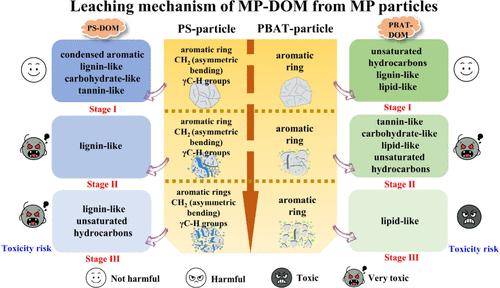New Insights into the Long-Term Leaching Process of Dissolved Organic Matter from Microplastics: Dynamic Formation and Transformation Mechanism
IF 11.3
1区 环境科学与生态学
Q1 ENGINEERING, ENVIRONMENTAL
引用次数: 0
Abstract
A deeper understanding of the photoaging dynamic release mechanism of microplastic-derived dissolved organic matter (MP-DOM) is crucial for revealing the behavioral patterns and ecological risks of microplastics. This study focused on the MP-DOM release process and molecular transformation mechanism of conventional polystyrene (PS) and biodegradable poly(butylene adipate-co-terephthalate) (PBAT) particles for 94 days under ultraviolet aging. Multistage kinetic simulation results indicated that the leaching rate constant and half-life of PS-DOM were approximately 10–3–10–6 and 30–300 times that of PBAT-DOM, respectively. The leaching process of PS-DOM could be categorized into three distinct stages: a rapid release period, plateau period, and slow release period, initially undergoing −C reactions of lignin-like compounds, followed by +H2O2 reactions of aromatic compounds, and finally −CH2 reactions of lignin-like compounds. PBAT-DOM displayed a rapid release period, slow release period, and degradation period, with lignin-like compounds as the main reaction components, experiencing −CH2, +O, and +H2O2 reactions, respectively. Noticeably, PS-DOM, along with its continuously increased molecular toxicity, exhibited a greater risk of toxicity relative to PBAT-DOM with a volcanic-like change of toxicity during the whole transformation process. This study reveals the staged characteristics and molecular transformation mechanisms of MP-DOM, which is beneficial for gaining a deeper understanding of their potential harm to eco-environment systems.

微塑料中溶解有机物长期浸出过程的新认识:动态形成和转化机制
深入了解微塑料源性溶解有机物(MP-DOM)的光老化动态释放机制,对于揭示微塑料的行为模式和生态风险至关重要。研究了常规聚苯乙烯(PS)和可生物降解聚己二酸丁二酯(PBAT)颗粒在紫外线老化94 d下MP-DOM的释放过程和分子转化机理。多阶段动力学模拟结果表明,PS-DOM的浸出速率常数和半衰期分别约为PBAT-DOM的10-3-10-6倍和30-300倍。PS-DOM的浸出过程可分为快速释放期、平台期和缓释期3个阶段,首先发生木质素类化合物的−C反应,其次是芳香族化合物的+H2O2反应,最后是木质素类化合物的−CH2反应。PBAT-DOM表现出快速释放期、缓慢释放期和降解期,以木质素类化合物为主要反应组分,分别发生−CH2、+O和+H2O2反应。值得注意的是,PS-DOM的分子毒性不断增加,其毒性风险相对于PBAT-DOM更大,在整个转化过程中毒性变化呈火山状。本研究揭示了MP-DOM的阶段性特征和分子转化机制,有助于深入了解其对生态环境系统的潜在危害。
本文章由计算机程序翻译,如有差异,请以英文原文为准。
求助全文
约1分钟内获得全文
求助全文
来源期刊

环境科学与技术
环境科学-工程:环境
CiteScore
17.50
自引率
9.60%
发文量
12359
审稿时长
2.8 months
期刊介绍:
Environmental Science & Technology (ES&T) is a co-sponsored academic and technical magazine by the Hubei Provincial Environmental Protection Bureau and the Hubei Provincial Academy of Environmental Sciences.
Environmental Science & Technology (ES&T) holds the status of Chinese core journals, scientific papers source journals of China, Chinese Science Citation Database source journals, and Chinese Academic Journal Comprehensive Evaluation Database source journals. This publication focuses on the academic field of environmental protection, featuring articles related to environmental protection and technical advancements.
 求助内容:
求助内容: 应助结果提醒方式:
应助结果提醒方式:


